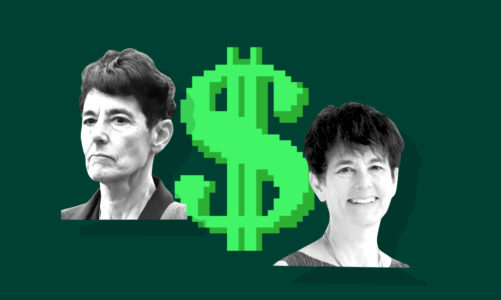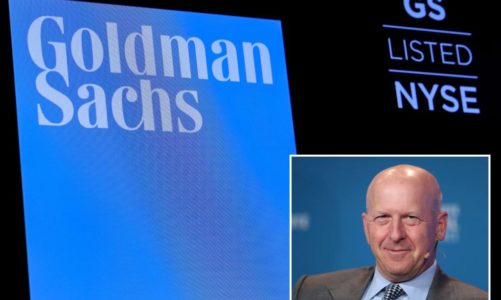‘The US banking system is sound and resilient,” Jerome Powell proudly stated, just days after the government took over First Republic Bank, marking the second-largest bank failure in US history. In our Fed chair’s world, First Republic is just another one-off, like Signature and Silicon Valley banks before it.
Sorry, one-offs (as Powell’s trying to frame First Republic) rarely come in threes, or fours if you count the ill-fated Credit Suisse’s forced merger with UBS by the Swiss.
Not long after Powell’s assurances, regional-bank stocks began to crash. Fox Business’s Eleanor Terrett and Charlie Brady reported that just in the past week, the sector is down 10%. For the year, regional-bank stocks are down 34.6% — compared to an 8.1% rise in the S&P 500.
The latest problem child appears to be LA-based PacWest Bancorp, with $40 billion in assets. It’s smaller than the $200-plus-billion at First Republic, but not insignificant, and its stock collapsed not long after Powell’s remarks. Shares recovered a bit Friday but not enough. They’re still down 82% from their 52-week high and its management continues to seek a white-knight savior.
The main culprit is, of course, higher interest rates. Also a lack of leadership. The Fed is the nation’s front-line bank regulator. But Wall Street appears to have less faith in Powell’s ability to stem the latest systemic threat to the US economy — a smoldering crisis threatening scores of midsized banks — than it had in his ability to foresee “transitory” inflation.
Ditto for Treasury Secretary Janet Yellen, another player in the bank regulatory apparatus. For weeks now, she’s also been telling the markets things are fine with our banks. Logic suggested quite the opposite, particularly at the regional-bank level where management collectively appears to have drunk from the same cup of Kool-Aid.

The regionals took chances so they could compete with the big banks. They were convinced the good times would never end when Powell & Co. printed money and Yellen spent like mad even after the economy opened from COVID. They made loans on terms that didn’t take into account that the economy would someday slow as it’s doing now. They loaded up on capital bought at the height of the market.
The Fed’s money printing came at a steep price, of course — that insidious tax on the working class known as inflation. Over the past year, Powell has jacked up rates eight times to slow the fast-burning economy.
Inflation may be falling even if it remains sticky, which means more rate increases are likely despite talk of a “pause.” That means speculative assets will be “normalizing,” a Wall Street term for continued compression of prices in stuff like crypto, meme stocks, tech, and now risky assets on regional-bank balance sheets.
Banking is a confidence game. Recall Jimmy Stewart’s character George Bailey in “It’s a Wonderful Life” trying to convince depositors from yanking their money from the Bailey Building and Loan. “You’re thinking of this place all wrong as if I had the money back in a safe. The money is not here . . . your money is in Joe’s house . . . and a hundred others.”
George Bailey prevented his “wonderful old Building and Loan” from collapsing, but just barely. He dipped into his own pocket, using his honeymoon savings as a short-term loan to pay some depositors. He was also able to convince enough people to have confidence in his ability to keep the bank afloat.
Yes, times were tough (it was the Great Depression). But depositors’ money, he argued, were in people’s houses — solid assets that will pay off over time. Their savings were secured as long as they didn’t panic.

Depositors on the run
We can use a few George Baileys now. As word of risk-taking spreads, regional depositors are running for the exits. They’re draining the banks of their capital and sending them into insolvency because they don’t know what they’re backing up, such as increasingly depressed commercial real estate. Their execs hide behind a phalanx of Pollyannaish flacks who can’t be trusted with the truth. First Republic dodged important questions during its last analysts call that guaranteed its demise.
Powell and Yellen offer bromides, too, and a patchwork of short-term fixes. A shotgun marriage arranged by the Feds allowed JPMorgan to buy First Republic in receivership with oodles of government guarantees. It did nothing to stem worries about the system, as this past week’s events demonstrated.
My banking sources tell me they expect policymakers to come up with another half-baked solution to stop depositors from moving their money out of the regionals: Extend deposit insurance well above the current $250,000 limit, possibly making it limitless, either explicitly or by declaring all regional banks “systemically important” so they get the same “too big to fail” designation as places like JPMorgan.
Sounds good, but interest rates offered on bank deposits suck. Extended deposit insurance won’t stop the drain because you can earn around 4% to 5% in a super-safe money market fund offered by money managers like Vanguard.
Another solution: Just let the regional banks fail and be taken over by the bigger, presumably better capitalized megabanks. But huge chunks of the nation’s lending apparatus just can’t be replaced by the big guys — JPM, Citi, BofA, and Wells Fargo. More bank lending is necessary to prevent a full-scale recession.
And how many bad banks like First Republic can Jamie Dimon and JPM’s balance sheet digest? JPM now controls nearly 17% of the nation’s deposits. Talk about too big to fail!
Sorry, there are no quick fixes for the pickle we’re in except possibly trying to avoid the sins of the past.
We need Jerome Powell to turn into George Bailey and start telling the country some hard truths. The Fed printed money when it wasn’t necessary. The hyperlow interest rates of the past three years lasted much longer than the existential threat of those COVID lockdowns to the economy. And now the bill is coming due.
𝗖𝗿𝗲𝗱𝗶𝘁𝘀, 𝗖𝗼𝗽𝘆𝗿𝗶𝗴𝗵𝘁 & 𝗖𝗼𝘂𝗿𝘁𝗲𝘀𝘆: nypost.com
𝗙𝗼𝗿 𝗮𝗻𝘆 𝗰𝗼𝗺𝗽𝗹𝗮𝗶𝗻𝘁𝘀 𝗿𝗲𝗴𝗮𝗿𝗱𝗶𝗻𝗴 𝗗𝗠𝗖𝗔,
𝗣𝗹𝗲𝗮𝘀𝗲 𝘀𝗲𝗻𝗱 𝘂𝘀 𝗮𝗻 𝗲𝗺𝗮𝗶𝗹 𝗮𝘁 dmca@enspirers.com




